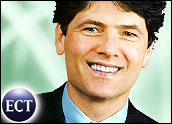
Managed care is facing a fundamental shift in the way it handles member relations. Historically, payors invested little in developing solid relationships with individuals. This was a logical arrangement as employers selected and paid plans, so sales, service and marketing resources were dedicated to keeping employers happy.
What about the individual member? Payor communication to members was limited to mandated communications andcustomer service resources to answer in-bound coverage and claim questions. This situation — combined with the fact that both employers and providers have been notoriously quick to throw the system “under the bus” in response to all patient complaints — has given managed care a pretty rotten reputation among consumers.
Hence the “trust gap.” Forrester Research published a study on the impact of managed care’s current member relations model. The study focused on consumer confidence in service providers and showed that 50 percent of study participants agreed with the statement, “My primary bank is always on my side for any problems or concerns I have.” Only 21 percent of participants agreed with the same statement about their primary health plan.
Shaking the CRM Model
Recently, consumerism arrived on the scene, and there’s little argument that it is having an enormous impact on managed care. Consumer Directed Health Plans (CDHPs), the financial services integration spurred by Health Savings Accounts (HSAs) and Flexible Spending Accounts (FSAs), the cost-shifting caused by tiered co-pays and tiered provider networks, and the implementation of Medicare Part D are all working to change the role patients play in healthcare. As an industry we talk about providing choice, but we know that these initiatives are largely about shifting risk and cost — and consequently responsibility — to the member.
In response, managed care is starting to shift its focus from serving the employer to serving the member. While consumer healthcare products and services are multiplying daily, efforts in member communications are lagging and, more often than not, leave members unhappy. For the most part, communications are designed with little or no coordination among functional groups. Service, billing, medical management, pharmacy management and claims operate in silos and communicate independently. The result of these disparate efforts is consumer confusion, frustration, an inability to manage care, and increasing dissatisfaction with the plan.
Lifecycle Driven Communications
As patients play an increasing role in managing their own healthcare, they are demanding — and they deserve — better access to information. Not necessarily more information — anyone who’s navigated a health plan’s Web portal has an opinion about the volume of information available — but access to the right information at the right time, in digestible increments and in an appealing format.
What does managed care have to do to meet this new consumer expectation? Ultimately, the right solution requires an integrated approach to communications that centers on the life events of the consumer instead of the daily operations of the plan. This approach is called “lifecycle driven communications.” The new CRM model for managed care is dependent on departmental silos coordinating communications so that every time a member hears from the plan, the information is timely and valuable.
Here’s an example of “lifecycle driven communications.” Let’s say a plan learns, through its integration with the provider’s electronic medical record system, that a member has just been diagnosed with diabetes. Within a couple of days, the plan sends the following automated outbound call to the member:
- “Our records show that Doctor Jones recently diagnosed you with type 2 diabetes. The American Diabetes Association says that early intervention is the best way to control this disease. That is why USACare has three programs designed to help you manage your treatment. At the end of this call, you’ll have an opportunity to hear more information about these programs to determine whether they are right for you. Also, since your out-of-pocket spending may increase based on your diagnosis, you may want to consider increasing your health savings account contribution to pay these costs with ‘pre-tax’ dollars. At the end of this call, you’ll have an opportunity to speak to a representative about adjusting your contribution. At this time, we’d like to get some information from you about additional insurance coverage you may have…”
In one “touch” of the member, the plan has made an offer of disease management services based on a gold-standard third party reference, given a recommendation to increase HSA allotment, and accomplished COB (Coordination Of Benefits) data collection. Consider that this unified approach replaces what traditionally would be four separate letters.
Communications are coordinated across clinical and administrative functional areas. Such efficiency brings cost savings and increased revenue to the plan and an increase in satisfaction and trust to the member. The customer relationship is managed more effectively with fewer net communications. This holistic approach will arguably result in better clinical outcomes which benefits all parties.
A Game Plan for Better Communications
Dramatic CRM overhauls can’t occur overnight. However, there are steps health plans can take today to move their organizations in the right direction. As a health plan manager, what can you do now to help insure the future success of your organization and best manage your customer relationships?
- 1. Create a “Communications Map” for your organization. Document who’s reaching out to your members, when they’re reaching out, what they’re saying when they reach out and how they’re saying it. at the business unit or departmental level. It will be difficult to coordinate member communications between silos. However, most companies today could take great steps toward improved results and member satisfaction simply by making communications more efficient within functional organizations. across an organization. Having a “Chief Member Relationship Executive” will make it easier to acquire resources across the organization and to keep your CRM initiative moving forward.
5. Implement new technologies that will help get you there faster. While healthcare has historically been slow to adopt new technologies, a successful CRM implementation will require it. Automated voice services are one available solution. These services enable managed care companies to design, deploy and manage HIPAA-compliant automated calls and are often the best way to reach out to patients and members to drive behavior, educate or collect information.
Today’s changing healthcare landscape is forcing the consumer to make more decisions. The current health plan member engagement and communication process is not designed for this “new” customer. To close the trust gap between health plans, consumers and providers, the communication model needs to move to lifecycle driven communications — a shift in the way plans relate to members. While it may mean undergoing a considerable transformation, managed care leaders who engage in such practices will win consumers’ trust and loyalty.
Stan Nowak is a founder and CEO of Silverlink Communications, an automated voice services company whose customers include seven of the top 10 health plans and collectively represent more than 150 millions lives.





































